Abstract
Annually, there are between 2500 and 3000 Christmas markets in Germany. While claiming to be rooted in century-old tradition, the current concept of the markets, shaped in the 1930s, gradually transformed from primarily mercantile operations to experiential events. In contemporary times, these markets also have quantifiable social and experiential dimensions. The last of these, the experiential dimension, is a mélange of visual, auditory, and olfactory components that create a compound sensory response—the “Christmas atmosphere”. There are copious intangible elements of these markets, which combined create a sum greater than the addition of each of the individual constituent components. We find the recognition of such collections of entwined intangible heritage is novel, warranting further research and documentation, as standard approaches to the identification and management of intangible cultural heritage are too limiting.
1. Introduction
Annually, there are between 2500 and 3000 Christmas markets (“Adventsmarkt”, “Christkindl Markt”, “Weihnachtsmarkt”) in Germany. Given the large number and the role these markets play in the cultural fabric of German society during the pre-Christmas season, it is surprising how comparatively little attention they have received in German academic literature.
In German tradition, Christmas markets form part of the Christmas complex of Advent (fourth Sunday before Christmas), St. Nicholas Day (6 December), Christmas Eve, Christmas, St. Stephens Day (26 December), and Epiphany (6 January). While all other events are rooted in Christian tradition and adhere to differing levels of spirituality (depending on denominational affiliation), Christmas markets have more mercantile and, in particular, consumption-oriented foundations that have become increasingly dominant. A few authors focused on the role of Christmas markets as expressions of mass culture at the interface of tradition and commercialism with an increasing disconnect between the Christian foundations of the Advent and Christmas period and the consumer-focused social experience. The majority of literature, however, focuses on the role of these markets in the annual economy of regional service centers, examining aspects of tourism and economic development.
The formal literature is augmented by a range of surveys commissioned by communities and the industry with at least one community carrying out longitudinal studies (Hagen/Westphalia since 2002). In the literature, the focus has been on the economics and cultural complexities of German Christmas markets, and research into the experiential component has been largely ignored to date.
This paper will examine the historic background of Christmas markets in Germany and the many dimensions that ensconce these markets into German culture and society. It will explore the multi-sensory experience of the Christmas market as a complex form of intangible heritage that necessitates appropriate research and documentation.
2. Historic Context to the Christmas Markets in Germany
Christmas markets developed during the medieval period as opportunities to purchase supplies and goods in the midwinter period in the run-up to Christmas. Whilst the early versions of Vienna’s December markets of 1296 are often quoted as the first Christmas markets in the world, these fourteen-day fairs did not include any specific associations with the Christmas celebrations, despite being held in the Advent period. Street markets in the town of Bautzen, Saxony, have been generally proclaimed as the first Christkindlmarkt in the area of modern Germany, whereby King Wenceslaus IV granted the city the right to hold a free meat market in 1384, giving butchers the right to sell meat until Christmas. However, whether this constitutes an actual Christkindlmarkt is disputed, and it has been argued that the beginnings of these Christmas markets are probably later than is often indicated in the media and popular science. Despite this uncertainty, continually operating annual markets include the Dresden Strietzelmarkt (since 1434) [1], the Strassburg market (since 1570), and the Nuremberg (Nürnberg) Christkindlmarkt (Figure 1) (at least since 1628), with the Dresden markets reported to have traded special Christmas pastries, such as gingerbread, in that year [2].
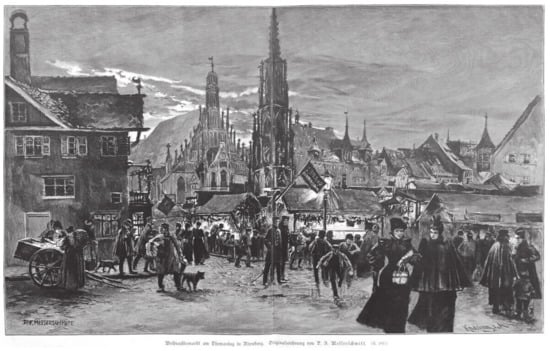
Figure 1.
Nuremberg, Christmas market on St. Thomas’s Day (21 December). Wood cut by Pius Ferdinand Messerschmitt [3].
2.1. Markets during the Seventeenth to Nineteenth Century
Evidence from the seventeenth and early eighteenth centuries suggests that many Christmas markets were located in close proximity to churches in order to attract church attendees, with stalls vending commodities, including pottery and foodstuffs such as meat and bakery, but also stalls selling specialty sweetbread and confectionery. The markets attracted workers, who received seasonal gratuities, as well as visitors from the countryside, and on occasion, nobility would provide their imprimatur through a formal visit (Figure 2). Over time, offerings at the stalls expanded to include candles, dolls, turnery, fur, and sweets. While trade was always licensed, Christmas markets became regulated activities in Berlin in 1750, both in terms of location (Breite Straße) and duration (11 December 11 to 6 January). During the nineteenth century, the principal German markets of Nuremberg, Dresden, Frankfurt, and Berlin could be considered true “Spielzeugmessen” or toy fairs due to the numerous dolls and figurines being sold in specialty stalls. The growth of such markets is correlated with the wealth of the community; the Berlin market was comprised of 50 stalls in 1650, 303 stalls in 1805, and about 600 stalls in 1840, all of which were erected and dismantled daily.[4]
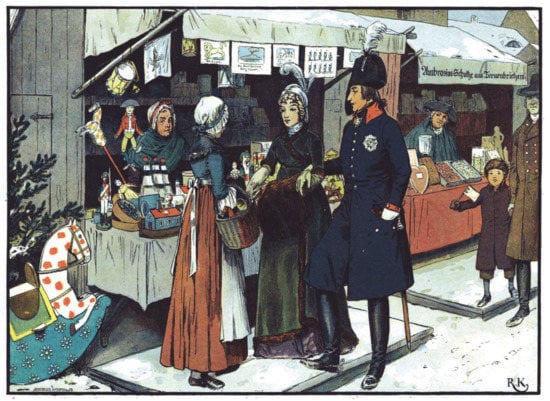
Figure 2.
Friedrich Wilhelm III and Queen Louise at the Berlin Christmas market, historicized wood cut by Richard Knötel [5].
2.2. Decline and Regulation
Later generations would look to the markets of “Christmas past”, such as the Berlin Christmas market of 1791, which was described in a novella by the Berlin author Ludwig Tieck. Tieck described the people of all ages and ways of life marveling at the plethora of toys, imitation (wax) fruits, marzipan and other confectionaries, candied fruits, and similar treats. Writing in 1834, however, he also noted that Christmas markets (in Berlin) peaked between 1780 and 1793, to be replaced by stores offering the same specialty goods in their own showrooms. By the 1870s, traditional mercantile interests increasingly regarded the Berlin Christmas market as unwanted competition. In conjunction with the implied political power of the emerging department stores, Christmas markets were relegated to increasingly peripheral settings, as well as with traders (mainly children) roaming the streets with their wares. Although widely deplored by residents, the Berlin city administration cited impediments to foot and horse traffic as justification for successive relocations of the venue for main Christmas markets to ever less desirable locations.
This trend was exacerbated by an increasing proportion of urban poor that further marginalized markets, which catered for the affluent middle-class despite being serviced by the rural poor in the form of hand-carved toys, as well by the urban poor in the form of retail services (Figure 3). After World War I, Christmas markets increasingly lost their economic market niche of selling seasonal gifts and toys (Figure 4) to the ubiquitous department stores, and similar trends played out in other German and Austrian cities [6].
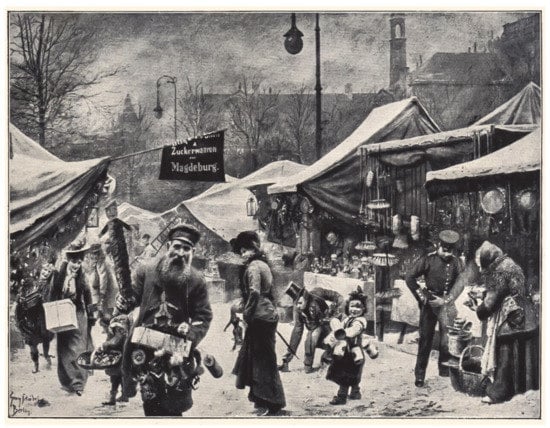
Figure 3.
Christmas market in Berlin during the Imperial era (pre-World War I). Reproduction of a painting by Wilhem Schoebel 1913 [9].
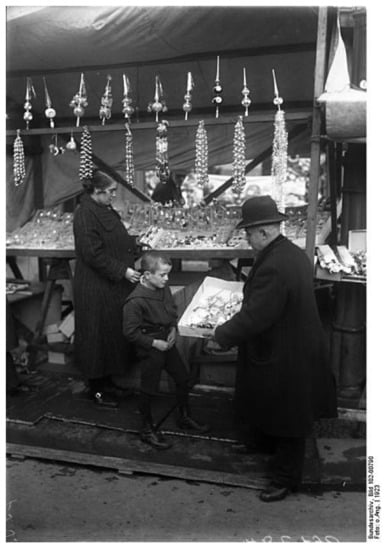
Figure 4.
Stall selling decorations for Christmas trees at the Berlin Christmas market at the Alexanderplatz in 1923 (source: Bundesarchiv 102-00790).
During the nineteenth century, communities regulated the markets and restricted what could be sold and who would be allowed to trade. The community of Halle, for example, allowed external traders despite protests by local traders, while Madgeburg and Frankfurt did not. The 1869 police order for Frankfurt, for example, was very prescriptive and stipulated that for the Christmas market from 5 December to 1 January, nothing could be sold during mass on 25 and 26 December, as well as on 1 January, and that only “genuine Christmas objects [were to be offered] such as children’s toys, Christmas trees, nativity scenes, gingerbread and confectionery.” Other early to mid-nineteenth century markets focused on the same range of products: a reference to the 1848 markets in Leipzig noted primarily gifts for children and singled out “a small Christmas tree, a box of lead soldiers, and a large gingerbread.” Depending on the socio-economic setting of the markets, even relatively poor people could acquire Christmas decorations and toys [7].
Little had changed in that regard by the end of the century (e.g., Vienna). The 1863 regulations for Berlin specifically excluded stalls that sold alcoholic beverages, as did the 1893 regulations for Hamburg [8].
2.3. Revival and the Modern Form
The re-emergence of the Christkindlmarkt in Nuremburg and other markets in the twentieth century was largely due to the reinvigoration of the market as a “wonderful German custom” under the National Socialist Party mayor, Willy Liebel, alongside festive ceremonies, speeches, and carol singing. In 1933, Liebel standardized the appearance of the roofed stalls and restricted the range of offerings to items that had a direct connection with Christmas, such as: angels made from lush gold, Christmas tree decorations, toys, dolls, picture books, arts and crafts, handicrafts, gingerbread, prune men, and sugar confectionery, as well as advent wreath binders and sellers of Christmas trees. Critically, however, the structured markets of the late 1930s added another component by incorporating food offerings, such as bratwurst stalls and herring roasters.
The Christmas atmosphere was engendered through Christmas decorations with garlands and glass balls, as well as fairy lights strung across stalls and festoon lights strung across light poles. The use of torches, as well as electric spotlights, added to the look and feel, albeit with Nazi overtones and an emphasis on a German Christmas. Similar developments occurred in Berlin in 1934, Dresden (1937), Wroclaw (Krakau) (1937), and Vienna (Figure 5). While claiming to be rooted in tradition, critical to these developments was the transformation of the Christmas markets from a primarily mercantile operation to an experiential event. Even during the early days of World War II (Figure 6) and after the collapse of Nazi Germany in 1945, the formula of offerings and the experiential nature of Christmas markets remained until the present day.
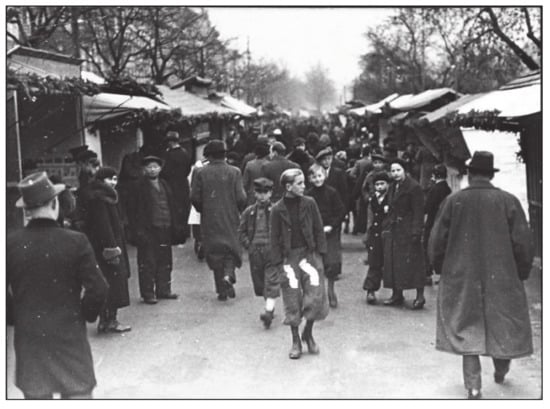
Figure 5.
Christmas market at the Neubaugürtel in Vienna ca. 1939 (Press Photo Agentur Schostal, source: author).

Figure 6.
Opening of the Berlin Christmas market at the Lustgarten, 19 December 1942 (Press Photo Atlantic-Boesig1942, source: author).
During the late 1960s to late 1970s, Christmas markets transformed from individual experiential events to those of mass culture, facilitated by increased personal wealth in the post-reconstruction period and by increased car ownership and, thus, individual mobility. This was aided when several communities extended the trading period of the Christmas markets to commence as early as the Friday before the first advent (usually last weekend in November). While, historically, all major regional centers seem to have operated such markets, most smaller German Christmas markets, as well as markets in industrial cities, are only 50 to 60 years old. This emergence can be correlated with the rise of consumerism and the attempt to promote local businesses during the Christmas shopping period to prevent the drift of consumers to larger regional centers [10,11,12].
Early on, Christmas markets focusing on Christmas trees, toys, and gingerbread were interpreted as a typical German custom. While Christmas markets have a long tradition in the German-speaking border regions of Italy (Tyrol), Switzerland, and France (Alsace), in the 1990s, German Christmas markets had become a “product” that was emulated in non-German speaking countries, such as the UK, the USA (Chicago, IL 1996; Columbus, OH 1999), Russia, Poland, Japan, Mexico, and India, both as open air markets and, in the case of Thailand, in shopping centers. While initially purely mercantile opportunities, some of these also developed along experiential lines.
3. The Mercantile, Social, and Experiential Dimensions of Christmas Markets
Today, there are reputedly almost 3000 annual Christmas markets throughout Germany, ranging from small single-weekend affairs in small communities to large-scale Christmas markets running from the last week in November to Christmas Eve. In 2007, the number of markets across the country topped 2100, with over forty of these being found in the Berlin area alone. Not surprisingly, as Christmas markets can attract very large numbers of visitors, local economies receive a massive boost during the pre-Christmas period. In 2012, the top ten Christmas markets attracted a combined 26.9 million visitors, with Cologne (Köln) alone attracting 4 million and 5 million in 2019[13]. Among the other traditional markets in historic settings, Frankfurt attracted 3 million, Munich (München) 2.8 million, and Nuremberg 2 million [14].
The shoppers are predominantly locals and drawn from nearby communities with less than a third travelling more than 100 km (ca 1 hr travel time). Visitors from further afield tend to be drawn only to Christmas markets at major historic town centers, such as Aachen, Cologne, Dusseldorf (Düsseldorf), Frankfurt, Mayence (Mainz), Munich, Munster (Münster), Nuremberg, Rothenburg, and Wurzburg (Würzburg). Travel companies offer daily bus excursions to the more iconic markets, such as Nuremberg, with the popularity underlined by the fact that on some weekends in the mid-1970s, up to 1000 buses arrived [15].
The centrality of the Christmas markets to the pre-Christmas experience is underlined by a set of marketing surveys. In 2012, 80% of respondents saw a visit to Christmas markets as obligatory, preferring smaller regional over larger markets. Additional marketing surveys in 2016–2018 found that 73% of the respondents could not imagine an Advent season without Christmas markets, that 71% intended to visit one, and that 69% became sentimental by the agglomeration of huts selling Christmas decorations and mulled wine. The fact that the markets were seen as too crowded (83%) and, in particular, over-priced (82%) did not diminish the experience. In early December 2019, 59% of female and 51% of male respondents planned to visit a Christmas market [16].
3.1. The Mercantile Dimension
For Germans, Christmas markets as ephemeral events have several dimensions: mercantile, social, and experiential. The mercantile dimension formed the foundation of the Christmas markets. As noted, during the medieval period, these markets provided opportunities for artisans, merchants, and producers to sell their wares in the midwinter period and for the public to purchase supplies and goods in the run-up to Christmas [17]. Over time, showmen augmented the offerings, turning a purely mercantile market into an event. In the modern incarnation, the markets are comprised almost equally of stalls selling goods and stalls selling confectionery, food, and drink. These are augmented by a small number of amusement rides, all of a subdued nature fitting in with the “Christmas atmosphere”.
During the second decade of this millennium, Christmas markets lost their role as an important venue to purchase Christmas presents to shopping centers and, increasingly, the internet. Significantly, the competition of on-line options is universal, affecting both towns that historically host Christmas markets and towns that have only done so in the past 50 years [18,19,20,21,22,23,24,25,26,27].
3.2. The Social Dimension
While the mercantile dimension was the primary driver for the initial establishment of the markets, and while many visitors will still purchase a Christmas tree ornament or a gift, the main function of the markets in the new millennium rests in the social dimension. Visitors of the markets stated that food and drink were the main reason they had come (34%), followed by spending time with friends or family (22%) and the experiential atmosphere (22%). Buying items for themselves (5%) or as presents (9%) rated low. The same preferences were also reflected in actual purchases, where 75% of attendees purchased food or drink and only 12% bought Christmas decorations or other souvenirs (9%). The deep-rootedness of this driver of participation is demonstrated by similar observations made a decade earlier at smaller markets, at regional markets, and at historic markets, as well as at more recently established markets, with a decreasing trend of purchases and an increasing trend of consumption of food and drink [28].
Given the primary drivers for visitation, it is also not surprising that almost half of those surveyed attended markets more than four times a year, frequently also visiting Christmas markets in nearby towns. The number of markets has been increasing steadily: approximately 950 markets in the 1970s; 1750 markets in 2002; 2100 markets in 2010; 2500 markets in 2018; and approximately 3000 markets in 2019. Concerns have been expressed that the trend might lead to an inflation of offerings, resulting in increased competition and increased demand for differentiation, which might result in a loss of quality [12].
3.3. The Experiential Dimension
The experiential dimension of a Christmas market is less readily definable. It is a mélange of visual, auditory, and olfactory components that create a plethora of sensory responses, acting upon the visitor simultaneously as well as discrete entities as the individual progresses through the market space. Visual stimuli are the colorful stalls and their array of wares, brought into sharper focus at night when surrounding visual cues of sky, buildings, and street furniture are negated. Festoon lights frame the experience (Figure 7) while lit Christmas trees and floodlit historic feature buildings (churches, palaces or town halls) provide visual anchors and landmarks (Figure 8 and Figure 9). Auditory stimuli are provided by Christmas music emanating from stalls and live music performances by choirs and bands, punctuating the low rumble of inter-personal communication among the multitude of people. At the periphery, the sounds of merry-go-rounds may be heard. Olfactory stimuli are ever present, with warm food odors dispersing far in the cold winter air: scents of mulled wine (“Glühwein”), candied roasted almonds, and roasted chestnuts compete with the odors of fried sausages (Bratwurst). These three primary stimuli are augmented by the less prominent tactile stimuli (which only apply to those visitors exploring the objects on sale with an eye on potential purchase) and the thermo-sensory stimuli on the skin (hands, face) caused by the cold of the outdoor markets (further emphasized by the visible breath). Drawing on Aho [29], we have to add these physical components, as well as the effects of memory and association implanted in the formative period during childhood, which are reinforced by cultural connotations and shared experiences in a social setting (see above).
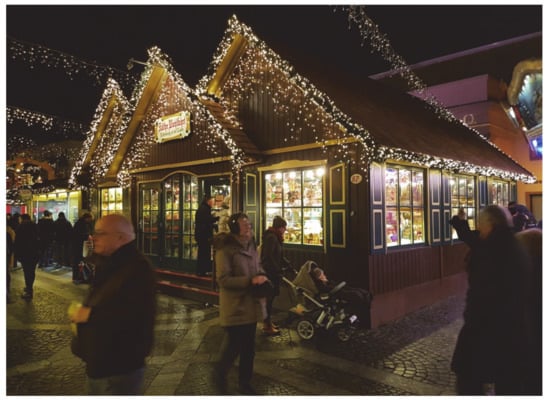
Figure 7.
Christmas market on the Domplatz at Mainz, 20 December 2016 (Photos DHRS).
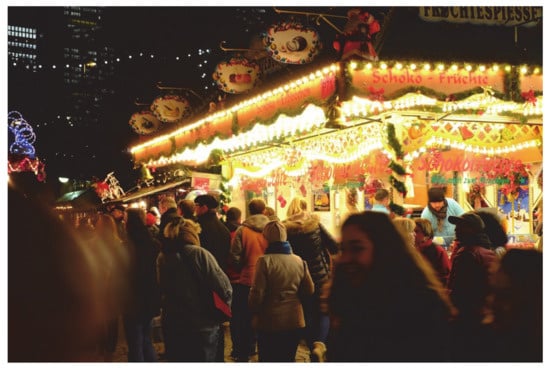
Figure 8.
Christmas market on the Römerberg at Frankfurt, 19 December 2016 (Photos DHRS).
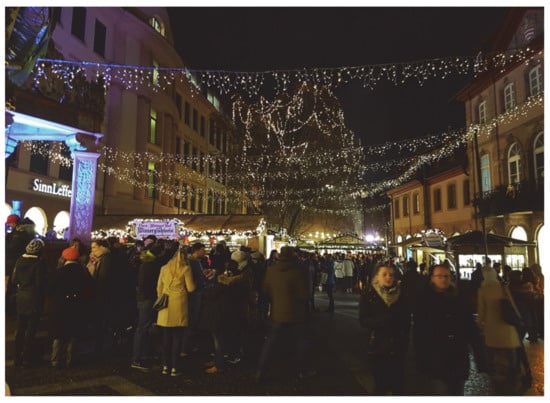
Figure 9.
Christmas market on the Domplatz at Mainz, 20 December 2016 (Photos DHRS).
The experiential dimension of Christmas markets is often shorthanded as “Christmas atmosphere” or “Christmas mood” and is regularly queried in visitor satisfaction surveys. The overall Christmas atmosphere is considered an important element of a successful and appealing Christmas market, followed by the appearance of the stalls [30,31]. Moreover, external visual elements of the Christmas markets also have a major influence on visitor satisfaction, with markets in the settings of historic town centers engendering in visitors a greater willingness to recommend them to others [31].
The integral components of a Christmas market were sub-zero Celsius temperatures, stalls selling mulled wine (79%), Christmas festoon lights (79%), and Christmas trees (78%), as well as stalls selling sweets (75%) and food (69%). Mulled wine (66%) and candied roasted almonds (48%) were seen to be among the quintessential elements of Christmas markets. Live music by choirs or brass bands was regarded as low quality and less significant for the experience (33%), as were children’s attractions such as merry-go-rounds (17%). Indeed, in 2016, 88% of all respondents preferred a traditional-style Christmas market without merry-go-rounds and other show-type rides [32].
Given the mercantile, social, and experiential dimensions, coupled with its economic significance, it is not surprising that Christmas markets materially add to a town’s image as well as brand, with Nuremberg pioneering that market segment. Not surprisingly, then, the tourism industry has promoted the socio-cultural experience of German Christmas markets either as a destination in its own right or as a value-adding element to either town-specific tourism or general winter tourism. Not only German markets were targeted but also European and overseas markets, such as the UK or the USA, with additional online promotion [33,34,35,36].
A 2018 survey of visitors at ten different Christmas markets found that 85% of the attendees were Germans, with the remainder from the Netherlands (6%) and other European countries (Austria, Belgium, Switzerland, UK). The economic significance of the Christmas markets reached beyond the immediate sales at the markets themselves. One third of respondents included an overnight stay of one or more nights, with a higher percentage of overnight stays in historic and picturesque towns.[31] It is interesting to note that the clientele of these markets is predominantly local, with their motivations for visiting being primarily the desire to experience the markets as a sense of nostalgia for a local past. This is unusual in experiential tourism and opens up avenues for future qualitative research [37,38,39].
The experiential dimension of Christmas markets has not seen extensive qualitative or quantitative analysis. An exception is a study by Kammerhofer-Aggermann et. al., who surveyed visitors at the Christkindlmarkt in Salzburg (Austria) trying to tease out the significance of visual, auditory, and olfactory characteristics of the pre-Christmas period [6]. They noted that a high level of importance was attributed to scents and odors, whereas the setting at the Mirabellplatz, flanked by the Salzburg minster and the palace, received polarized responses. Fairy and festoon lighting were important, as well as typical Christmas music and sounds, while the decoration of the stalls was deemed to be of lesser relevance.
4. Discussion
The cultural heritage of a community is defined by the tangible evidence that circumscribes the physical environment (e.g., historic properties, monuments, cultural landscapes), its artefacts (e.g., archaeological material, art collections, public art), and its intangible heritage (e.g., customs, language, oral history). Much of contemporary heritage management is concerned with the preservation of physical structures and museum objects,[40], as well as the preservation of intangible cultural practices. While the rhetoric advocates the preservation of such heritage for the benefit of future generations,[41] the management processes primarily serve the ideological and socio-political interests of the present.[42] The management intangible heritage as currently practiced tends to focus on languages, cultural practices, and expressions in the form of music and dance. The 2003 UNESCO Convention for the Safeguarding of Intangible Cultural Heritage, for example, defines the intangible cultural heritage as “the practices, representations, expressions, knowledge, skills [and associated objects]…that communities, groups and, in some cases, individuals recognize as part of their cultural heritage” and which manifest themselves inter alia as “oral traditions and expressions, including language …heritage; performing arts; social practices, rituals and festive events; knowledge and practices concerning nature and the universe; traditional craftsmanship.”[43] Intangible aspects of heritage outside this standard discourse, however, tend to be overlooked or regarded as too difficult to address. As shown elsewhere, aural heritage, the sounds generated by and prevalent in the human-generated environment (as opposed to music), tends to be under-researched and mismanaged.[44,45] Similarly, other sensory aspects, such as the olfactory components of cultural practices, tend to be overlooked.
While Convention for the Safeguarding of Intangible Cultural Heritage alludes to “festive events”, the usage in its context, as well as other references to the term in the publication, strongly suggest that festive events are celebratory in nature and tied in with social practices and rituals [43].
Thus, annual festivals such as the German Christmas markets are not covered per se. While cases have been made for the heritage value of festivals, drawing on their intangible heritage aspects, such as the Fallas Festival in Valencia (Spain),[46] or the Swabian-Alemannic Carnival [47], these festivals are organized, choreographed events (albeit with individual contributions), rather than organically developed and executed entities. Furthermore, none of these studies truly consider the multi-sensory components and focus primarily on the visual aspects or the music performances as discrete entities. Some movement in this direction has been the methodology advanced for the evaluation of the cultural heritage values of the Flamenco, a dance which, while itself an intangible cultural practice, includes a number of additional intangible elements that give complexity to the dance, such as feelings, technique, innovation, distinctiveness, virtuosity, and composition in terms of rhythm, harmony, or melody.[48] Their methodology draws on interviews with experts, a double system survey for spectators and experts, and correlation and exploratory factor analysis, which crystallizes three criteria: feelings, virtuosity, and composition.[48] As the Flamenco is a performance, these criteria can be developed into a formal set that is then used to grade various interpretations and performances, akin to the way performances in dance competitions, gymnastics, or figure skating are assessed. Additional assessment can be carried out similar to auditions by actors or musicians, although these are more open to the subjective interpretation and evaluation by the assessor.
As discussed, Christmas markets in Germany are not solely about the mercantile dimension, or more recently, tourism, but form an essential part of the history and culture of the cities and villages that host them. As discussed, there are copious intangible elements that combine to form the recognized “Christmas atmosphere” of German Christmas markets, such as the distinctive visual, auditory, olfactory stimuli, and tactile sensory responses, yet the combination of these facets creates a sum greater than the addition of each of the individual constituent components. It is this combination of a multisensory collective that gives these markets their own unique intangible heritage. As these markets have changed substantially over the past centuries, the sensory experiences/intangible heritage aspects currently experienced are naturally different from those of the past. Unless the intergenerational transmission of intangible aspects of culture is canonized, e.g., Indigenous Australian cultural knowledge and languages,[49], the cultural heritage value is informed and shaped by the common experiences of the oldest living generation (i.e., grand-parents and great-grandparents). While akin to the shifting baseline syndrome in historic ecology,[50] cultural heritage values are mutable entities and defined by their relevance to the majority of the community.[51] Thus, the intangible heritage aspects of Christmas markets are defined by the significant sensory experiences of the markets as they presented themselves in the immediate pre- and post-World War II period. With continual intergenerational change, however, the significant sensory experiences will undergo change as well. It is, therefore, important to document both the individual components and the intangible multisensory collective, while, at the same time, acknowledging that social heritage value is fluid [52,53].
The intangible heritage of Christmas markets is just one example that requires consideration and documentation, as the underlying issue of documenting multi-sensory communal events stretches to many other examples around the world. Global examples of such an intangible heritage collective include, inter alia, the Songkran celebration of the Buddhist New Year in Thailand, the Holi Festival in India, the Gion Festival in Kyoto, and La Tomatina celebration in Buñol, Spain. It would certainly be interesting to investigate how the sensory components of these events are experienced by attendees—especially as all sensory experiences are extremely subjective—and how they may be documented effectively as a form of intangible heritage.
While components of intangible heritage have been previously evaluated in cultural festivals, and research has identified methods to analyze and archive existing and historic odors, aural landscapes and soundmarks, and visual experiences, to the authors’ knowledge, to date, no research has identified successful methods to both document and archive these components as a collective in the social sphere. In this manner, we seem to be still trapped in the nineteenth century, with the best documentation emulating the word-smithery of Ludwig Tieck. A way forward may well be the creation of virtual reality that augments the “standard” visual and auditory sensations with olfactory stimuli and also haptic and kinesthetic experiences. The use of such a documentation technique, however, then raises its own problems in terms of intergenerational digital archiving. In addition, with the continual evolution of Christmas markets over time, the notion of documenting “authenticity” presents unique and complex problems. These include issues of not only the determination of what a “genuine” Christmas market experience actually is but then establishing correct time frames and situational/locational parameters for apposite documentation.
Author Contributions
D.H.R.S., M.P. contributed equally to the paper. Both authors have read and agreed to the published version of the manuscript.
Funding
This research received no external funding.
Conflicts of Interest
The authors declare no conflict of interest.
References
- Wozel, H. Der Dresdner Striezelmarkt. Geschichte und Tradition des ä ltesten deutschen Weihnachtsmarktes; Husum Druck- und Verlagsgesellschaft: Husum, Germany, 2009. [Google Scholar]
- Hirschfelder, G. Kultur im Spannungsfeld von Tradition, Ökonomie und Globalisierung: Die Metamorphosen der Weihnachtsmärkte. Z. Volkskd. 2014, 110, 1–32. [Google Scholar]
- Anonymous. Weihnachtsmärkte. Die Gart. 1897, 824, 826–835. [Google Scholar]
- Schneider, J. 11 Dezember 1750: Weihnachtsmarkt in der Breiten Straße; Novitäten: Berlin, Germany, 1999; pp. 74–77. [Google Scholar]
- Röchling, C.; Knötel, R.; Friedrich, W. Die Königin Luise in 50 Bildern für Jung und Alt; Paul Kittel: Berlin, Germany, 1896. [Google Scholar]
- Kammerhofer-Aggermann, U.; Hiebl, E.; Keul, A.G.; Bachleitner, R.; Schreuer, M. Weihnachtsmärkte: Zentren der Sehnsüchte und des Tourismus. Tour. J. 2003, 7, 329. [Google Scholar]
- Schrakamp, J. Deutsche Heimat; American Book Company: New York, NY, USA, 1912. [Google Scholar]
- Polizei-Behörde. Reglement für die Abhaltungdes Weihnachtsmarktes (Doms) of 31 October 1893. In Gesetzsammlung der Freien und Hansestadt Hamburg; Lütke & Wulff: Hamburg, Germany, 1893; pp. 84–86. [Google Scholar]
- M.O. Der Weihnachtsmarkt in alt-Berlin. Velhagen Klasings Mon. 1913, 28, 620–627.
- Werbegemeinschaft Markoldendorf. Geschichte der Werbegemeinschaft. Available online: https://www.wg-markoldendorf.de/über-uns-1/geschichte/ (accessed on 23 December 2020).
- Jürgens, U. Weihnachtsmarkt Siegen. Eine Besucheranalyse 2007. Siegen. Beitr. 2009, 13–14, 259–270. [Google Scholar]
- Johnson, G.; Weinert, S. Imoha-Studie: Weihnachtsmärkte als Wirtschaftsfaktor. Wochenmarkt. Hauszeitung DMG Marktgilde. 2002. Available online: https://www.marktgilde.de/fileadmin/Oeffentlich/Downloads/Hauszeitung/2002/Der_Wochenmarkt_Nr22.pdf (accessed on 23 December 2020).
- Hawley, S. Germans Flocked to the Shops to Get Their Christmas Shopping Done. Now It’s Forced Them into Lockdown for the Holiday. Available online: https://www.abc.net.au/news/2020-12-16/germans-face-a-tough-christmas-with-covid-19-restrictions/12986132 (accessed on 23 December 2020).
- Schrahe, C.; Rast, C.; Baltin, J.; Neef, S.; Peiffer, M. Wirtschaftliche Bedeutung der Volksfeste in Deutschland. Aktuelle Situation, Entwicklungen, Trends; ift Freizeit-und Tourismusberatung GmbH: Cologne, Germany, 2013. [Google Scholar]
- Göbel, E.; Schramm, M. Konsum, Region und Weihnachtsmärkte. Dresdner Striezelmarkt und Nürnberger Christkindlesmarkt im Vergleich (1933–2000). Comparativ 2001, 11, 51–65. [Google Scholar]
- Sonnenberg, A.-K. To-Do-Listen bis Weihnachten. Available online: https://yougov.de/news/2019/12/05/-do-listen-bis-weihnachten/ (accessed on 23 December 2020).
- Peters, J.; Vetterlein, U. Weihnachtsmärkte—ein boomender Faktor—Synergie oder Konkurrenz zum stationären Einzelhandel? Handel Fokus. Mitt. IfH 2003, 3, 173–180. [Google Scholar]
- Gansser, O.; Reich, C. FOM Weihnachtsumfrage 2020, Ergebnisse für Nürnberg; ifes Institut für Empirie & Statistik, FOM Hochschule für Oekonomie & Management: Münich, Germany, 2020. [Google Scholar]
- Gansser, O.; Reich, C. FOM Weihnachtsumfrage 2020, Ergebnisse für Frankfurt am Main; ifes Institut für Empirie & Statistik, FOM Hochschule für Oekonomie & Management: Münich, Germany, 2020. [Google Scholar]
- Gansser, O.; Reich, C. FOM Weihnachtsumfrage 2020, Ergebnisse für Hagen; ifes Institut für Empirie & Statistik, FOM Hochschule für Oekonomie & Management: Münich, Germany, 2020. [Google Scholar]
- Gansser, O.; Reich, C. FOM Weihnachtsumfrage 2020, Ergebnisse für Siegen; ifes Institut für Empirie & Statistik, FOM Hochschule für Oekonomie & Management: Münich, Germany, 2020. [Google Scholar]
- Gansser, O.; Reich, C. FOM Weihnachtsumfrage 2020, Ergebnisse für München; ifes Institut für Empirie & Statistik, FOM Hochschule für Oekonomie & Management: Münich, Germany, 2020. [Google Scholar]
- Gansser, O. FOM Weihnachtsumfrage 2017. Ergebnisse für Frankfurt am Main. Einkaufsverhalten in Bezug auf Weihnachtsgeschenke; ifes Institut für Empirie & Statistik, FOM Hochschule für Oekonomie & Management: Münich, Germany, 2017. [Google Scholar]
- Gansser, O. FOM Weihnachtsumfrage 2017. Ergebnisse für Nürnberg. Einkaufsverhalten in Bezug auf Weihnachtsgeschenke; ifes Institut für Empirie & Statistik, FOM Hochschule für Oekonomie & Management: Münich, Germany, 2017. [Google Scholar]
- Gansser, O. FOM Weihnachtsumfrage 2017. Ergebnisse für Hagen. Einkaufsverhalten in Bezug auf Weihnachtsgeschenke; ifes Institut für Empirie & Statistik, FOM Hochschule für Oekonomie & Management: Münich, Germany, 2017. [Google Scholar]
- Gansser, O. FOM Weihnachtsumfrage 2017. Ergebnisse für München. Einkaufsverhalten in Bezug auf Weihnachtsgeschenke; ifes Institut für Empirie & Statistik, FOM Hochschule für Oekonomie & Management: Münich, Germany, 2017. [Google Scholar]
- Gansser, O. FOM Weihnachtsumfrage 2017. Ergebnisse für Siegen. Einkaufsverhalten in Bezug auf Weihnachtsgeschenke; ifes Institut für Empirie & Statistik, FOM Hochschule für Oekonomie & Management: Münich, Germany, 2017. [Google Scholar]
- BSM. Weihnachtsmärkte als Wirtschaftsfaktor für Kommunen und Tourismus in der Bundesrepublik Deutschland sowie dessen Beitrag zur Leistungssteigerung im mittelständischen Schaustellergewerbe und Markthandel; Bundesverband Deutscher Schausteller und Marktkaufleute: Bonn, Germany, 2002. [Google Scholar]
- Aho, S.K. Towards a general theory of touristic experiences: Modelling experience process in tourism. Tour. Rev. 2001, 56, 33–37. [Google Scholar] [CrossRef]
- Stadt Hagen. Statistisches Jahrbuch Hagen 2008; Stadt Hagen: Hagen, Germany, 2008. [Google Scholar]
- Wölfle, F.; Schnorbus, L. Weihnachtsmärkte-Charakterisierung der Besucher und Bedeutung Unterschiedlicher Faktoren für Diese; IUBH Internationale Hochschule: Erfurt, Germany, 2019. [Google Scholar]
- YouGov Team. Weihnachtsmarkt mit Oder ohne Fahrgeschäfte, Glühwein Oder Kinderpunsch, 5 Grad Plus Oder Minus. Available online: https://yougov.de/news/2016/11/21/weihnachtsmarkt-mit-oder-ohne-fahrgeschafte-gluhwe/ (accessed on 23 December 2020).
- European Best Destinations. The 14 Best Christmas Markets in Germany for 2020. Available online: https://www.europeanbestdestinations.com/christmas-markets/christmas-in-germany/ (accessed on 23 December 2020).
- Kutter, M. The Top 14 Christmas Markets to Visit in Germany. Available online: https://theculturetrip.com/europe/germany/articles/germanys-top-11-christmas-markets/ (accessed on 23 December 2020).
- Emerson, C. German Christmas Markets. Available online: https://web.archive.org/web/20050308230034/https://www.howtogermany.com/pages/winter.html (accessed on 23 December 2020).
- Viator. Germany’s Christmas Markets and How to Celebrate in Bavaria. Huffington Post. 2012. Available online: https://www.huffpost.com/entry/germany-christmas-markets_b_2221329/ (accessed on 9 December 2020).
- Meacci, L.; Liberatore, G. A senses-based model for experiential tourism. Tour. Manag. Stud. 2018, 14, 7–14. [Google Scholar] [CrossRef] [Green Version]
- Prentice, R. Experiential cultural tourism: Museums & the marketing of the new romanticism of evoked authenticity. Mus. Manag. Curatorship 2001, 19, 5–26. [Google Scholar]
- Smith, W.L. Experiential tourism around the world and at home: Definitions and standards. Int. J.Serv. Stand. 2006, 2, 1–14. [Google Scholar] [CrossRef]
- Kreps, C.F. Liberating Culture: Cross-Cultural Perspectives on Museums, Curation, and Heritage Preservation; Routledge: London, UK, 2003. [Google Scholar]
- Spennemann, D.H.R. Futurist rhetoric in U.S. historic preservation: A review of current practice. Int. Rev. Public Nonprofit Mark. 2007, 4, 91–99. [Google Scholar]
- Spennemann, D.H.R. Beyond “Preserving the Past for the Future”: Contemporary Relevance and Historic Preservation. CRM J. Herit. Steward. 2011, 8, 7–22. [Google Scholar]
- UNESCO. Basic Texts of the 2003 Convention for the Safeguarding of Intangible Cultural Heritage’ for Its Protection and Promotion; UNESCO: Paris, France, 2020. [Google Scholar]
- Parker, M. The Heritage of Sound in the Built Environment: An Exploration. Bachelor’s Thesis, Charles Sturt University, Albury, Australia, 2018. [Google Scholar]
- Spennemann, D.H.R.; Parker, M. Hitting the ‘Pause’ Button: What does COVID tell us about the future of heritage sounds? Noise Mapp. 2020, 7, 265–275. [Google Scholar] [CrossRef]
- Royo, B.S. The value of intangible cultural heritage: The case of the Fallas Festival in Valencia, Spain. In Contemporary Issues in Cultural Heritage Tourism; Kaminski, J., Arnold, D., Benson, A.M., Eds.; Routledge: Abingdon, UK, 2014; pp. 264–286. [Google Scholar] [CrossRef]
- Hanke, B.; Welz, J. Bundesweites Verzeichnis Immaterielles Kulturerbe; Deutsche UNESCO-Kommission: Bonn, Germany, 2019. [Google Scholar]
- Heredia-Carroza, J.; Palma Martos, L.; Aguado, L.F. How to Measure Intangible Cultural Heritage Value? The Case of Flamenco in Spain. Empir. Stud. Arts 2020, 39, 149–170. [Google Scholar] [CrossRef]
- Treloyn, S.; Googninda Charles, R.; Nulgit, S. Repatriation of song materials to support intergenerational transmission of knowledge about language in the Kimberley region of northwest Australia. In Endangered Languages Beyond Boundaries Publisher; Norris, M.J., Ed.; Foundation for Endangered Languages: Hungerford, Berkshire, 2013; pp. 18–24. [Google Scholar]
- Soga, M.; Gaston, K.J. Shifting baseline syndrome: Causes, consequences, and implications. Front. Ecol. Environ. 2018, 16, 222–230. [Google Scholar] [CrossRef] [Green Version]
- Spennemann, D.H.R. Gauging Community Values in Historic Preservation. CRM J. Herit. Steward. 2006, 3, 6–20. [Google Scholar]
- Jones, S. Wrestling with the Social Value of Heritage: Problems, Dilemmas and Opportunities. J. Community Archaeol. Herit. 2017, 4, 21–37. [Google Scholar] [CrossRef] [Green Version]
- Canning, S.; Spennemann, D.H.R. Contested space: Social value and the assessment of cultural significance in New South Wales, Australia. In Heritage Landscapes: Understanding Place and Communities. Proceedings of the Lismore Conference; Cotter, M.M., Boyd, W.E., Gardiner, J.E., Eds.; Southern Cross University Press: Lismore, Australia, 2001; pp. 457–468. [Google Scholar]
Publisher’s Note: MDPI stays neutral with regard to jurisdictional claims in published maps and institutional affiliations. |
© 2021 by the authors. Licensee MDPI, Basel, Switzerland. This article is an open access article distributed under the terms and conditions of the Creative Commons Attribution (CC BY) license (https://creativecommons.org/licenses/by/4.0/).